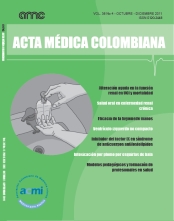Diagnosis of oral health and oral hygiene habits in patients with chronic kidney disease
Abstract
Objective: to establish the oral health condition of patients with chronic kidney disease (CKD) who received care in a center for renal therapy, as well as its relationship with nutritional and inflammatory markers and doses of erythropoietin received.
Patients: patients with chronic kidney disease treated at RTS Caldas, in the following programs: predialysis, post-renal transplant, hemodialysis, and peritoneal dialysis. All these patients had attended any of these programs uninterruptedLy for at least three months; they agreed to participate in the study and had the necessary laboratory studies, as well as registered doses of erythropoietin.
Methods: three hundred thirty-six patients met the inclusion criteria: 24 (7%) in predialysis, 164 (49%) in hemodialysis, 114 (34%) in PD and 34 (10%) in post-renal transplant. The following demographic data were established and assessed: Silness and Loe plaque indices (oral Health) and Loe and Silness gingival indices, caries experience in Decayed-Missing-Filled Teeth Index (DMFT) and stomatologic diagnosis. Additionally, laboratory reports were recorded indicating the inflammation state of the patients: albumin, ferritin, transferrin saturation and erythropoietin dosage.
Results: pre-dialysis and post-renal transplant populations did not give sufficient information to be included in the statistical analysis. The following information was obtained from dialysis patients: 63% had good oral hygiene, 33% fair, and only 3% had poor oral hygiene. The prevalence of periodontal disease was high, affecting 75% of patients. Severe gingivitis was present in 35-38% of patients. The DMFT index showed a high prevalence of caries. No relationship was found between laboratory results for inflammatory markers, periodontal health, and doses of erythropoietin.
Conclusions: the oral hygiene of dialysis patients is satisfactory. However, they have a high prevalence of periodontal disease and tooth decay. This suggests that factors related to the uremic medium, pH and salivary flow favor its appearance. The evaluation of these parameters in future studies could provide more conclusive results, as well as the use of more sensitive markers of inflammation. Early evaluation provided by dental professionals is a priority for all patients with CKD in order to prevent the occurrence of periodontal disease.
Metrics
Copyright (c) 2019 Eliana E. Muñoz López,César Augusto Restrepo,Jose Arnoby Chacón

This work is licensed under a Creative Commons Attribution 4.0 International License.
Acta Medica Colombiana uses the CC-BY 4.0 license. Authors retain all rights over their work.


